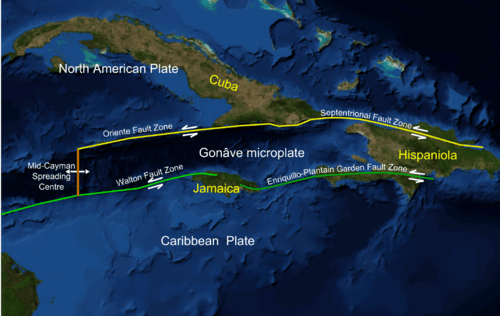Mid-Cayman Rise

The Mid-Cayman Rise or Mid-Cayman Spreading Center is a relatively short (110 km long) divergent plate boundary in the middle of the Cayman Trough. It forms part of a dominantly transform boundary that is part of the southern margin to the North American Plate. It developed during the Eocene when the northern part of the Caribbean Plate collided with the Bahamas Platform, forcing the southern boundary to propagate southwards. This boundary initially formed as two strike-slip faults with a large left-stepping offset between them, generating a pull-apart basin. Continuing movement on the boundary and extension within the pull-apart led to the formation of an area of oceanic crust containing a north-south trending spreading center that remains active to the present day. It is an ultra-slow spreading center with an opening rate of 15–17 mm per year.[1]
When the spreading center formed, all the displacement on the Swan Islands Transform Fault was transferred by the Mid-Cayman Rise to the Septentrional-Oriente fault zone. During the Late Miocene, the leading edge of the Caribbean Plate began to collide with the Bahamas Platform. This led to the development of a new fault system, formed of the Walton fault zone and the Enriquillo–Plantain Garden fault zone, carrying some of the plate boundary displacement and creating the Gonâve Microplate. Eventually all the displacement on the plate boundary is expected to move onto the southern fault system as the microplate becomes accreted to the North American Plate, at which point the Mid-Cayman Rise will become extinct.[2]
References
- ↑ Hayman N.W.; Grindlay N.R.; Perfit M.R.; Mann P.; Leroy S.; de Lépinay B.M. (2011). "Oceanic core complex development at the ultraslow spreading Mid-Cayman Spreading Center". Geochemistry, Geophysics, Geosystems. 12 (3). Bibcode:2011GGG....12.AG02H. doi:10.1029/2010GC003240.
- ↑ Mann, P.; Taylor, F.W.; Edwards, R. Lawrence; Ku, Teh Lung (1995). "Actively evolving microplate formation by oblique collision and sideways motion along strike-slip faults: An example from the northeastern Caribbean plate margin". Tectonophysics. 246 (1–3): 1–69. Bibcode:1995Tectp.246....1M. doi:10.1016/0040-1951(94)00268-E.